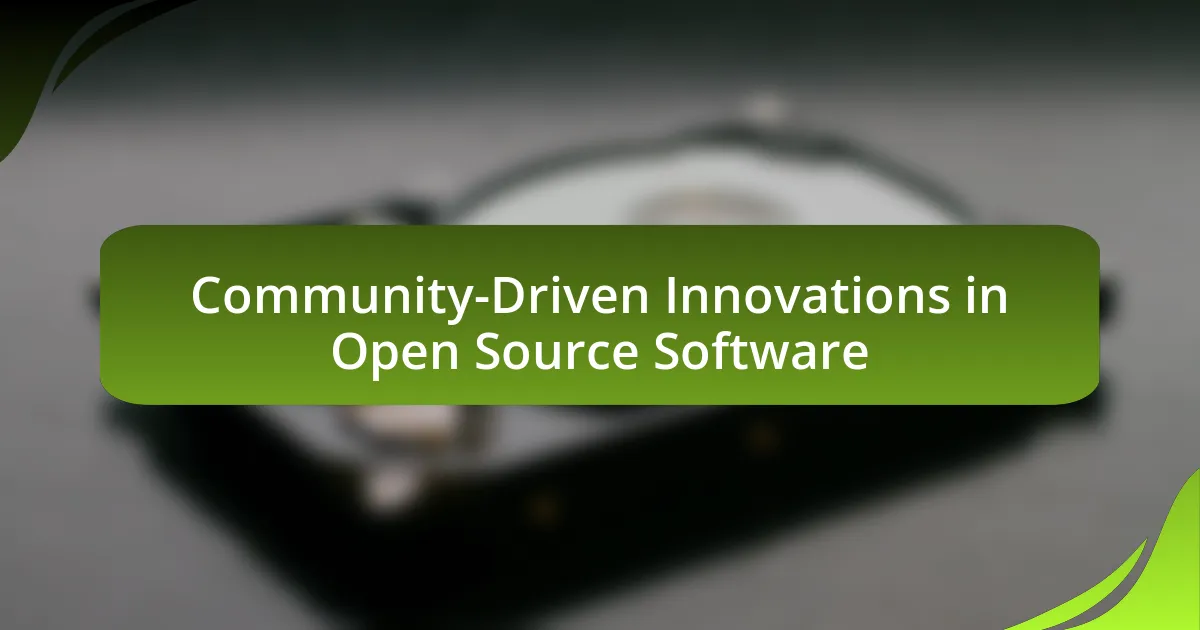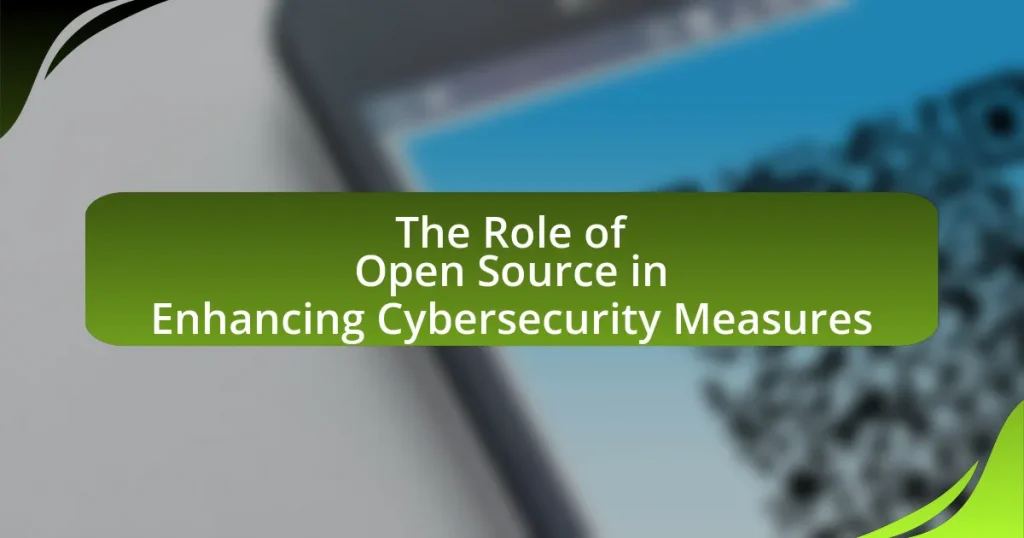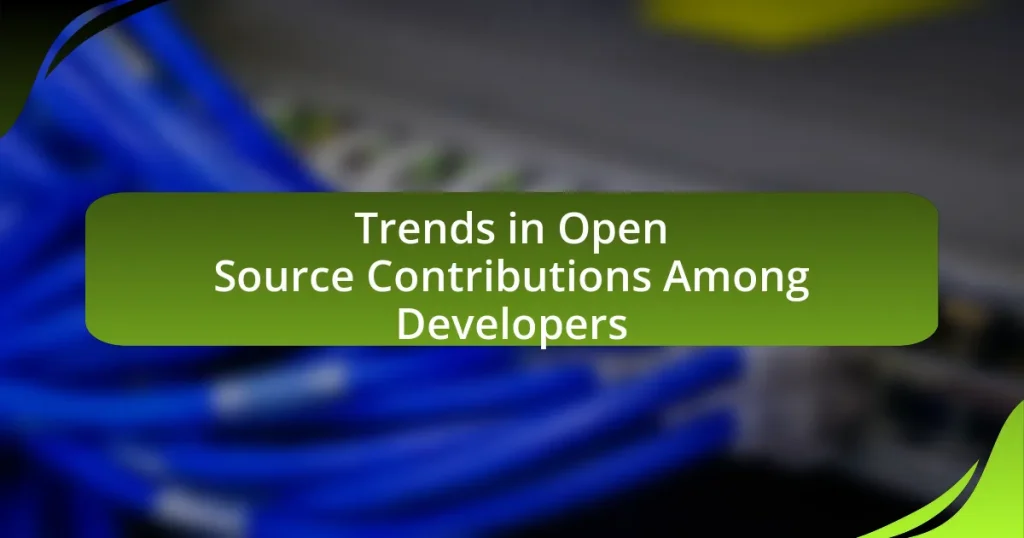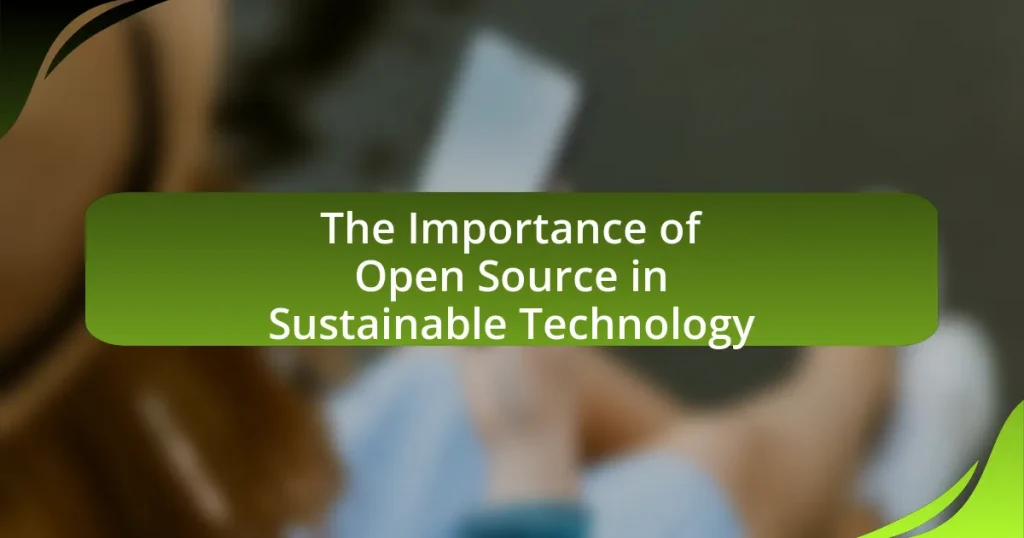Community-driven innovations in open source software are advancements that arise from collaborative efforts within the open source community, involving contributions from diverse individuals and organizations. These innovations differ from traditional software development by emphasizing open participation and collaboration, leading to rapid iterations and enhanced software quality. Key roles of community members include providing feedback, identifying bugs, and suggesting features, which collectively drive the evolution of software. The article explores the importance of collaboration, transparency, and effective communication in fostering innovation, while also addressing challenges such as resource limitations and contributor burnout. Additionally, it highlights best practices for enhancing community engagement and onboarding new contributors, underscoring the significant impact of mentorship on innovation within the open source ecosystem.
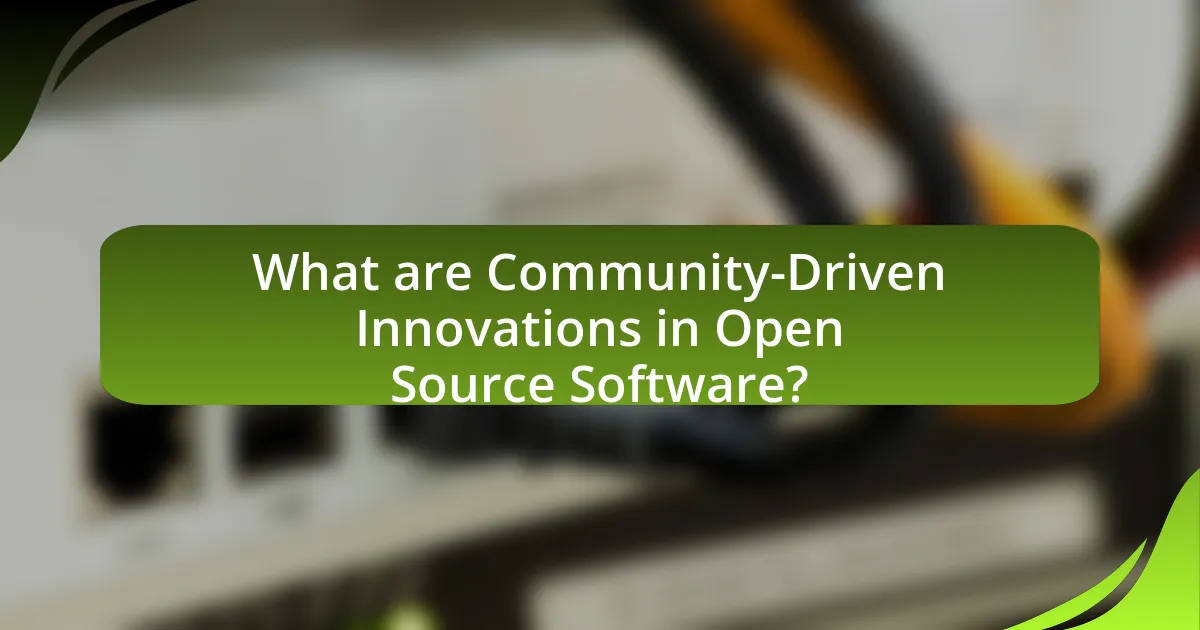
What are Community-Driven Innovations in Open Source Software?
Community-driven innovations in open source software refer to advancements and improvements that emerge from collaborative efforts within the open source community. These innovations often arise from contributions by diverse individuals and organizations who share a common interest in enhancing software functionality, security, and usability. For instance, the Linux operating system has seen significant enhancements through community contributions, leading to its widespread adoption in various industries. This collaborative model fosters rapid iteration and problem-solving, as developers can share code, feedback, and ideas, resulting in a more robust and adaptable software ecosystem.
How do community-driven innovations differ from traditional software development?
Community-driven innovations differ from traditional software development primarily in their collaborative nature and open participation. In community-driven innovations, a diverse group of contributors, including developers, users, and stakeholders, actively participate in the design, development, and improvement of software, often leading to rapid iterations and diverse perspectives. This contrasts with traditional software development, which typically follows a more hierarchical structure where a centralized team makes decisions and controls the development process.
Evidence of this difference can be seen in the success of open-source projects like Linux and Apache, where contributions from thousands of individuals have led to robust and flexible software solutions. According to a 2020 study by the Open Source Initiative, 90% of developers believe that community involvement enhances software quality, highlighting the effectiveness of community-driven approaches compared to traditional methods.
What roles do community members play in the innovation process?
Community members play crucial roles in the innovation process by contributing ideas, providing feedback, and collaborating on projects. Their involvement enhances creativity and accelerates problem-solving, as diverse perspectives lead to more robust solutions. For instance, in open source software development, community members often identify bugs, suggest features, and contribute code, which collectively drives the evolution of the software. Research indicates that community engagement can significantly increase the rate of innovation, as seen in projects like Linux and Apache, where active participation has led to rapid advancements and widespread adoption.
How does collaboration enhance innovation in open source software?
Collaboration enhances innovation in open source software by enabling diverse contributions from a global community of developers. This collective effort leads to a broader range of ideas, skills, and perspectives, which accelerates problem-solving and creativity. For instance, projects like Linux and Apache have thrived due to contributions from thousands of developers, resulting in rapid advancements and robust solutions. Research indicates that open source projects with higher levels of collaboration often produce more innovative features and improvements, as seen in studies analyzing the success of collaborative platforms like GitHub, where active participation correlates with increased software quality and functionality.
Why are community-driven innovations important for the open source ecosystem?
Community-driven innovations are crucial for the open source ecosystem because they foster collaboration, enhance software quality, and accelerate development. These innovations arise from diverse contributions, allowing for a wide range of perspectives and expertise, which leads to more robust and versatile software solutions. For instance, the Linux operating system has benefited significantly from community contributions, resulting in a stable and secure platform that powers a vast majority of servers worldwide. Additionally, studies show that projects with active community involvement tend to have higher rates of bug fixes and feature enhancements, demonstrating the direct impact of community engagement on software improvement.
What impact do these innovations have on software quality and security?
Community-driven innovations in open source software significantly enhance software quality and security. These innovations foster collaborative development, leading to more rigorous code reviews and diverse testing scenarios, which improve the overall robustness of the software. For instance, studies have shown that open source projects benefit from contributions by a wide range of developers, resulting in faster identification and resolution of vulnerabilities. According to a 2021 report by the Open Source Security Foundation, open source software is often more secure than proprietary software due to the transparency of its code, allowing for continuous scrutiny and improvement by the community. This collaborative approach not only elevates the quality of the software but also strengthens its security posture, as vulnerabilities are more likely to be discovered and patched quickly.
How do community-driven innovations foster inclusivity and diversity?
Community-driven innovations foster inclusivity and diversity by actively engaging diverse groups in the development process, ensuring that multiple perspectives are represented. This approach allows for the creation of solutions that address the needs of various communities, as seen in open source software projects where contributors from different backgrounds collaborate. For instance, the Mozilla Foundation’s initiatives have demonstrated that involving underrepresented groups in technology development leads to more equitable outcomes, as diverse teams are better equipped to identify and solve a wider range of problems. Additionally, community-driven platforms often implement inclusive practices, such as mentorship programs and accessible documentation, which further promote participation from individuals with varying levels of expertise and experience.

What are the key characteristics of successful community-driven innovations?
Successful community-driven innovations are characterized by collaboration, inclusivity, adaptability, and user-centric design. Collaboration among diverse stakeholders fosters a rich exchange of ideas, enhancing creativity and problem-solving. Inclusivity ensures that various voices and perspectives are represented, which leads to more comprehensive solutions. Adaptability allows innovations to evolve in response to user feedback and changing needs, ensuring relevance over time. User-centric design focuses on the actual needs and experiences of users, resulting in more effective and widely accepted solutions. These characteristics are evident in successful open-source projects, where community engagement and iterative development processes lead to robust and sustainable innovations.
How does transparency contribute to successful innovations?
Transparency fosters successful innovations by enhancing collaboration and trust among community members in open source software. When contributors have access to clear information about project goals, decision-making processes, and code changes, they are more likely to engage actively and share their insights. For instance, a study by the University of Cambridge found that open communication in software projects leads to a 30% increase in contributor participation, which directly correlates with higher innovation rates. This openness not only encourages diverse input but also accelerates problem-solving, as community members can quickly identify and address issues. Thus, transparency is a critical factor in driving innovation within community-driven open source software projects.
What practices ensure effective communication within the community?
Effective communication within the community is ensured through regular meetings, transparent information sharing, and active engagement on collaborative platforms. Regular meetings foster direct interaction, allowing members to discuss ideas and resolve issues in real-time. Transparent information sharing, such as maintaining open documentation and accessible communication channels, ensures that all members are informed and can contribute effectively. Active engagement on collaborative platforms, like forums or chat applications, encourages ongoing dialogue and feedback, which is crucial for community-driven innovations in open source software. These practices collectively enhance trust, collaboration, and productivity within the community.
How does feedback influence the innovation cycle?
Feedback significantly influences the innovation cycle by providing critical insights that guide the development and refinement of ideas. In the context of community-driven innovations in open source software, feedback from users and contributors helps identify bugs, usability issues, and feature requests, which in turn informs iterative improvements. For instance, studies have shown that open source projects that actively solicit and incorporate user feedback tend to experience higher rates of adoption and satisfaction, as evidenced by the success of platforms like GitHub, where user contributions and feedback directly shape project evolution. This continuous loop of feedback and adaptation accelerates innovation, ensuring that the software remains relevant and effective in meeting user needs.
What tools and platforms facilitate community-driven innovations?
Tools and platforms that facilitate community-driven innovations include GitHub, GitLab, and Bitbucket, which provide collaborative environments for developers to share and contribute to open source projects. These platforms enable version control, issue tracking, and code review, fostering community engagement and innovation. For instance, GitHub hosts millions of repositories and supports features like pull requests and discussions, which enhance collaboration among developers globally. Additionally, platforms like Slack and Discord serve as communication tools that allow community members to discuss ideas, share feedback, and coordinate efforts in real-time, further driving innovation in open source software.
Which version control systems are most commonly used?
The most commonly used version control systems are Git, Subversion (SVN), and Mercurial. Git is widely recognized for its distributed architecture and is the backbone of platforms like GitHub and GitLab, which host millions of repositories. Subversion, while less popular than Git, is still used in many enterprise environments for its centralized model. Mercurial, similar to Git, offers a distributed version control system but has a smaller user base. According to the 2021 Stack Overflow Developer Survey, over 90% of developers reported using Git, highlighting its dominance in the field.
How do project management tools support community collaboration?
Project management tools support community collaboration by providing centralized platforms for communication, task management, and resource sharing. These tools facilitate real-time collaboration among community members, enabling them to coordinate efforts, track progress, and share feedback efficiently. For instance, platforms like GitHub and Trello allow contributors to manage projects collectively, assign tasks, and monitor deadlines, which enhances transparency and accountability within the community. Research indicates that effective use of project management tools can lead to increased participation and engagement in open-source projects, as they streamline workflows and reduce barriers to collaboration.
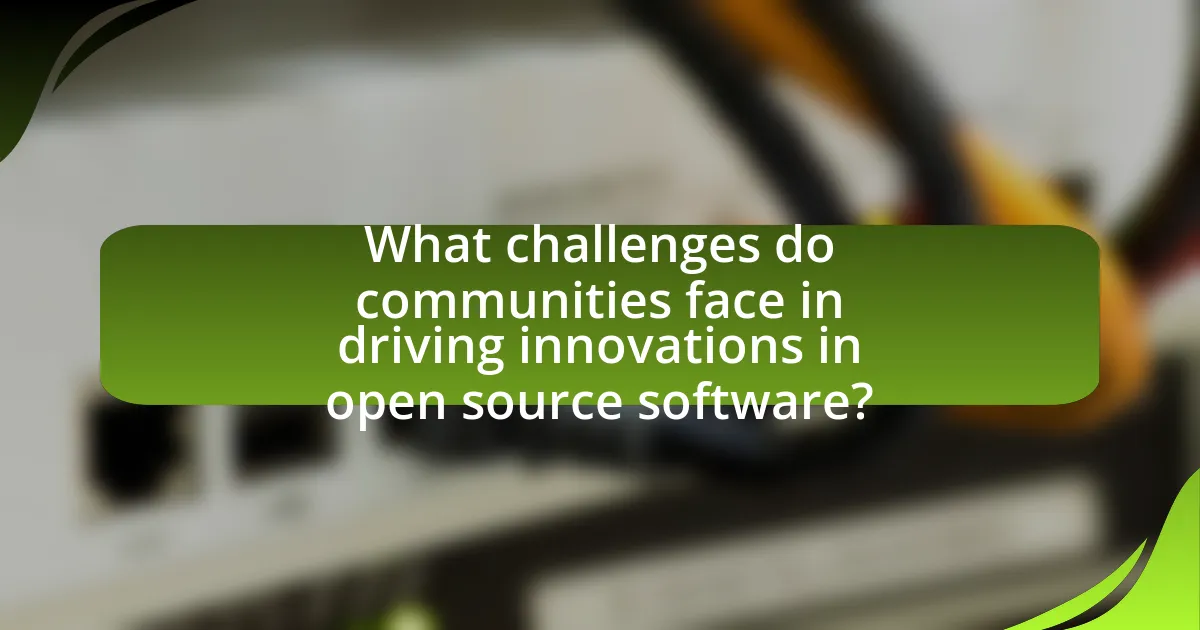
What challenges do communities face in driving innovations in open source software?
Communities face several challenges in driving innovations in open source software, including resource limitations, lack of coordination, and sustaining contributor engagement. Resource limitations often manifest as insufficient funding or manpower, which can hinder the development and maintenance of projects. Lack of coordination among diverse contributors can lead to fragmented efforts, making it difficult to align goals and share knowledge effectively. Additionally, sustaining contributor engagement is a significant challenge, as volunteers may lose interest or face competing commitments, resulting in decreased project momentum. These challenges are supported by studies indicating that many open source projects struggle to maintain active contributor bases and adequate funding, which directly impacts their innovation capabilities.
How can conflicts within the community hinder innovation?
Conflicts within the community can significantly hinder innovation by creating divisions that disrupt collaboration and knowledge sharing. When community members are at odds, they may withhold information, resources, or support, which are essential for fostering innovative ideas. For instance, a study by Eric von Hippel in “Democratizing Innovation” highlights that collaborative environments are crucial for innovation, and conflicts can lead to a breakdown in these collaborative efforts. Additionally, research published in the “Journal of Open Source Software” indicates that open source projects with high levels of conflict often experience slower development cycles and reduced contributions, ultimately stifling innovation.
What strategies can be employed to resolve conflicts effectively?
Effective strategies to resolve conflicts include active listening, mediation, and collaborative problem-solving. Active listening ensures that all parties feel heard and understood, which can de-escalate tensions. Mediation involves a neutral third party facilitating discussions to help reach a mutually acceptable solution. Collaborative problem-solving encourages participants to work together to identify common goals and develop solutions that satisfy everyone involved. Research indicates that these strategies can lead to more sustainable resolutions, as they foster communication and understanding among conflicting parties.
How does burnout among contributors affect project sustainability?
Burnout among contributors significantly undermines project sustainability by reducing the availability and productivity of key team members. When contributors experience burnout, their motivation and engagement decline, leading to decreased contributions and potential project stagnation. Research indicates that high levels of burnout can result in a 50% increase in turnover rates among contributors, which disrupts continuity and knowledge retention within the project. Furthermore, projects that rely on volunteer contributions, such as many open-source initiatives, are particularly vulnerable; a study published in the Journal of Open Source Software found that projects with high contributor burnout often face challenges in maintaining active development and community support. This cycle of burnout and attrition ultimately jeopardizes the long-term viability of the project.
What are the common misconceptions about community-driven innovations?
Common misconceptions about community-driven innovations include the belief that they lack structure and are solely driven by volunteers. In reality, many community-driven projects have established governance models and dedicated contributors who provide consistent support. Additionally, some people think that community-driven innovations are less reliable than those developed by corporations; however, studies show that open-source software can achieve high levels of quality and security, often surpassing proprietary solutions. For instance, the 2020 Open Source Security Foundation report highlighted that open-source projects like Linux and Apache are widely trusted and used in critical systems globally.
Why is the perception of open source as less professional misleading?
The perception of open source as less professional is misleading because many open source projects are developed and maintained by highly skilled professionals and organizations. For instance, major companies like Google, Microsoft, and IBM actively contribute to open source projects, demonstrating that these initiatives are backed by substantial expertise and resources. Additionally, open source software often undergoes rigorous peer review and testing, which can lead to higher quality and security standards compared to some proprietary software. The success of widely used open source projects, such as Linux and Apache, further illustrates that open source can be both professional and reliable, challenging the stereotype of being amateurish.
How does the community’s size impact innovation potential?
The size of a community significantly impacts its innovation potential, as larger communities tend to generate more diverse ideas and solutions. A study by the Massachusetts Institute of Technology found that open source projects with larger contributor bases produced higher-quality software and more innovative features, demonstrating that increased participation fosters creativity and problem-solving. Additionally, larger communities facilitate greater collaboration, allowing for the pooling of resources and expertise, which further enhances innovation capabilities.
What best practices can enhance community-driven innovations in open source software?
Best practices that can enhance community-driven innovations in open source software include fostering inclusive participation, establishing clear communication channels, and providing comprehensive documentation. Inclusive participation ensures diverse contributions, which can lead to innovative solutions; for instance, projects like Mozilla Firefox have thrived by welcoming contributions from a wide range of developers and users. Clear communication channels, such as forums and chat platforms, facilitate collaboration and idea exchange, as seen in the success of the Kubernetes community, which utilizes Slack and mailing lists effectively. Comprehensive documentation supports new contributors by lowering entry barriers, exemplified by projects like Django, which offers extensive guides and tutorials, leading to a more engaged community. These practices collectively create an environment conducive to innovation and sustained community involvement.
How can communities effectively onboard new contributors?
Communities can effectively onboard new contributors by implementing structured mentorship programs that pair experienced members with newcomers. This approach facilitates knowledge transfer and provides personalized guidance, which has been shown to increase retention rates among new contributors. For instance, a study by the Open Source Initiative found that projects with mentorship programs saw a 30% higher engagement level from new contributors compared to those without such initiatives. Additionally, providing clear documentation and resources helps newcomers understand project goals and workflows, further enhancing their integration into the community.
What role does mentorship play in fostering innovation?
Mentorship plays a crucial role in fostering innovation by providing guidance, support, and knowledge transfer to emerging talent. In the context of community-driven innovations in open source software, mentors help novice developers navigate complex projects, encouraging creative problem-solving and collaboration. Research indicates that mentorship can significantly enhance the skills and confidence of mentees, leading to increased contributions and innovative solutions within the community. For instance, a study by the National Mentoring Partnership found that mentored individuals are 55% more likely to enroll in college and 78% more likely to hold leadership positions, demonstrating the long-term impact of mentorship on personal and professional growth, which directly translates to innovation in collaborative environments like open source software.
